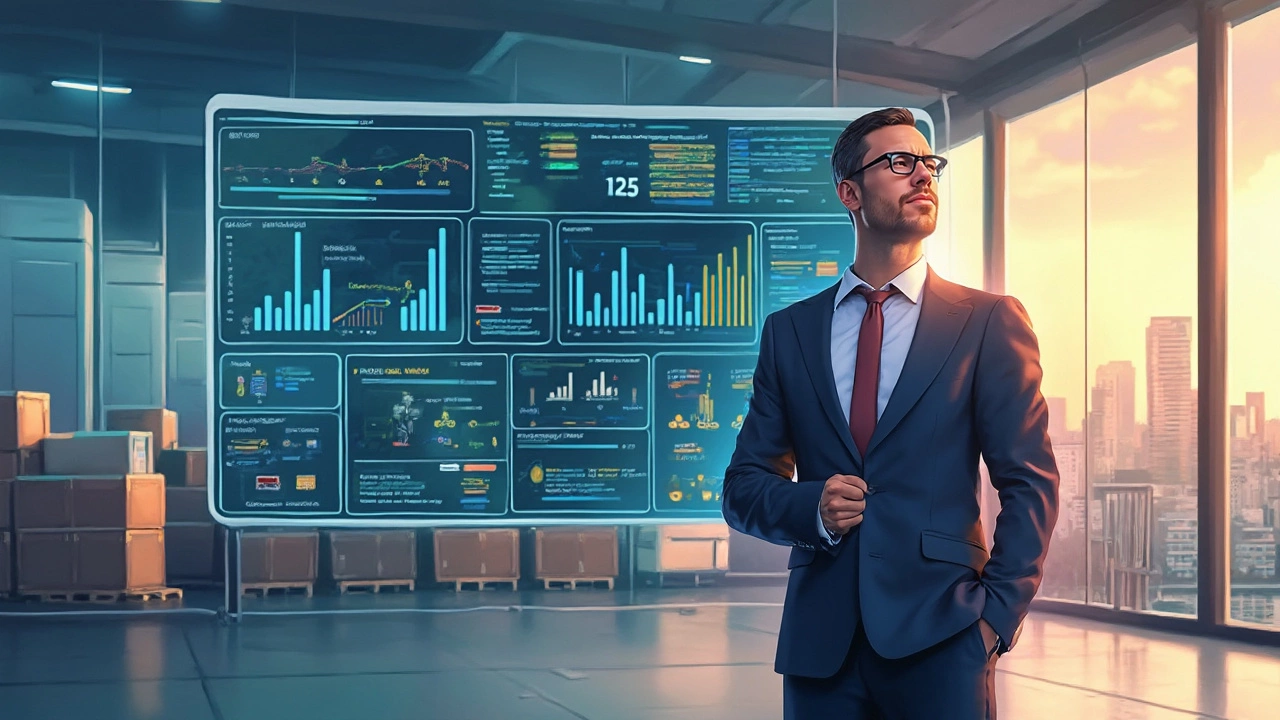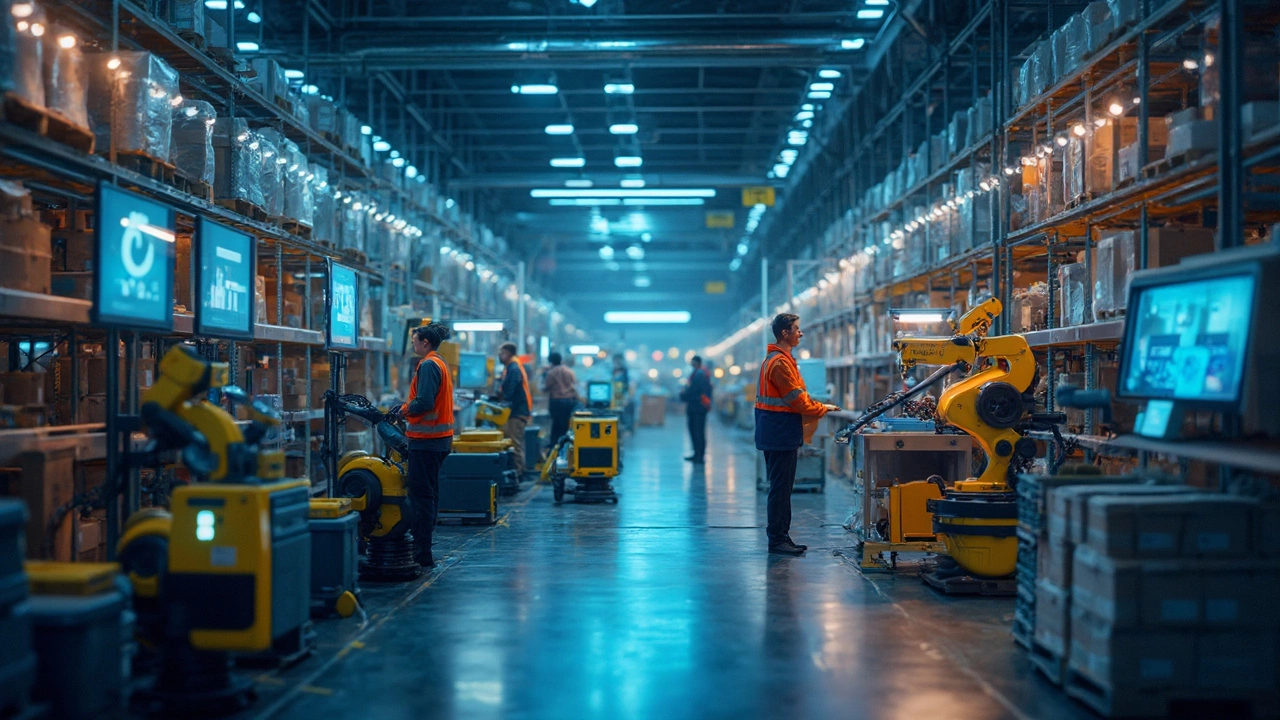Ever wondered how warehouses manage to juggle products, people, and processes so smoothly? It often boils down to one crucial tool: ERP, or Enterprise Resource Planning systems. In the world of warehousing, ERP is the magic wand that connects all the dots—inventory, orders, shipments, you name it. It's like having the brains of the operation all in one place.
ERP systems bring a massive advantage because they unify different functions under one umbrella. Imagine checking stock levels, processing orders, and scheduling shipments without jumping from one software to another. With ERP, it's all there at your fingertips, making life much easier and helping you avoid costly mistakes.
Plus, ERP systems offer real-time data, which is a game changer for decision-making. Whether you're optimizing supply chains or tackling logistics challenges, having up-to-the-minute information is priceless. And while setting up an ERP might feel like climbing a mountain, the payoff in terms of efficiency and productivity makes it worth every step.
- Introduction to ERP in Warehousing
- Benefits of Implementing ERP Systems
- Core Features of ERP for Warehouses
- Challenges and Solutions in ERP Implementation
- Case Studies of ERP Success
- Future Trends in Warehouse ERP Systems
Introduction to ERP in Warehousing
Diving into the world of warehouses without mentioning ERP systems is like talking about farming without tractors. ERP, or Enterprise Resource Planning, isn't just technical jargon—it's the backbone of efficient warehouse management. These systems are developed to coordinate every nook and cranny of warehousing operations.
ERP in warehouses means having a central hub that connects everything from inventory management to shipping schedules. Imagine managing a chaotic stockroom without running around like a headless chicken. Instead of running in circles, an ERP helps you organize and streamline every step, making sure nothing slips through the cracks.
Why Warehouses Need ERP
Let's be honest, dealing with tons of inventory and complex supply chain logistics isn't for the faint-hearted. That's where ERP steps in. These systems take over repetitive tasks, freeing up valuable human resources for more important things. Plus, they minimize mistakes by providing real-time updates, which is crucial for keeping customers happy and the business booming.
Key Functions
What makes an ERP essential in modern warehouses? Several features make it a must-have:
- Inventory Management: Keeps track of stock levels, movements, and replenishments.
- Order Processing: Automates the order cycle from picking to packing and shipping.
- Supply Chain Optimization: Ensures smooth coordination among suppliers, distributors, and warehouses.
ERP systems can be a game-changer. Those who dive into the digital playbook quickly realize how much easier and precise their operations become.
The Numbers Speak
A study conducted in 2024 showed that warehouses using ERP systems saw a 40% improvement in their overall efficiency within the first year of implementation. If that's not a solid reason to consider ERP, I don't know what is!
Benefits of Implementing ERP Systems
Thinking about upgrading your warehouse operations? Enter ERP systems! They're game changers in making warehouse life a breeze. With the right setup, they centralize all your processes, eliminating the chaos of juggling multiple systems.
Enhanced Efficiency
ERP systems streamline workflows, making tasks like inventory management and order tracking faster. No more scrambling through heaps of paperwork or switching between applications. Everything’s integrated, so you get things done quicker.
Better Accuracy, Less Errors
Errors can be a nightmare in warehouse solutions. An ERP minimizes human error by automating data entry and other routine tasks. For example, automated inventory updates mean you’re less likely to sell something out of stock.
Real-Time Data and Insights
Who doesn’t love having all the info at your fingertips? With ERP, you get real-time data on stock levels, shipment statuses, and more. This means you can tackle any hiccups before they snowball into major issues.
Cost Savings
Although setting up ERP can be an investment, the long-term savings are significant. By streamlining processes and reducing errors, your operational costs can take a nosedive.
In case you’re wondering if businesses actually see such benefits, here’s a handy table to put things into perspective:
| Feature | Efficiency Improvement |
|---|---|
| Inventory Management | 30% reduction in errors |
| Order Processing | 25% faster completion |
| Data Management | 20% more accurate reporting |
Convinced yet? If maximizing efficiency and cutting down on headaches sounds good, then an ERP is definitely for you. It could be your ticket to a smoothly run warehouse.
Core Features of ERP for Warehouses
Introducing ERP systems into warehousing isn't just about going digital—it's like getting a digital assistant that keeps everything running smoothly. Here, we'll explore the essential features that make ERP systems so invaluable in a warehouse setting.
Inventory Management
The crown jewel of any ERP system is its ability to manage inventory efficiently. Instead of manually tracking stock levels, ERP software automates this process, reducing errors and ensuring you're never caught off guard with low stock. It keeps tabs on what's coming in and going out, all in real-time.
Order Processing
No more shuffling through paperwork or spreadsheets when it comes to order processing. ERP systems streamline order management, from receipt to fulfillment, ensuring accuracy and speed. This not only optimizes workflow but also boosts customer satisfaction by reducing turnaround times.
Shipping and Logistics
Getting products out the door swiftly and accurately is crucial. ERP systems integrate with shipping and logistics, providing detailed tracking and reducing risks of delays and misdeliveries. This means you can promise more reliable service levels to your customers.
Data and Reporting
An often overlooked yet powerful feature is the robust data and analytics capabilities. Having access to detailed reports on sales, inventory levels, and supply chain performance helps managers make informed decisions quickly.
Automation Features
Talk about a time-saver! Automation in ERP systems doesn't just stop at inventory or orders. Think of automated notifications, triggers for re-orders, and even automated billing. By reducing manual tasks, staff can focus on strategic activities rather than routine ones.
Integration Capabilities
ERP systems are like glue, connecting various operations under one platform. It can seamlessly integrate with existing tools and software, be it accounting, CRM, or logistics platforms, ensuring all systems work in harmony without hiccups.
The power of an ERP system lies in weaving together these features to not just manage but enhance your entire warehouse operation. It’s an investment that, when done right, pays off in efficiency, accuracy, and ultimately, cost savings.

Challenges and Solutions in ERP Implementation
Diving into ERP for the first time can feel like a rollercoaster. While the idea of having a super-efficient warehouse solution is exciting, the road to get there can be bumpy. Let's break down some common challenges and how you can tackle them with ease.
Challenge: Overwhelming Complexity
ERP systems often come with a ton of features, which can be daunting. Many folks don’t know where to start, making mistakes or feeling overwhelmed.
Solution: Start by mapping out exactly what your warehouse needs. Prioritize the most critical functions, like inventory management or order processing. Work with your ERP vendor to customize the system to suit these primary needs. This way, you can start small and then expand as you become more comfortable with the system.
Challenge: Resistance to Change
Not everyone in the team will jump up and cheer for a new ERP system. Resistance to change is real, and it can significantly slow down implementation.
Solution: Involve your team from the get-go. Make them part of the decision-making process, listen to their concerns, and offer training sessions. Showing how ERP can make their jobs easier can help win them over. Celebrate small wins together to keep morale high!
Challenge: Data Migration Woes
Transferring existing data into an ERP system isn’t always straightforward. It can lead to data loss or inaccuracies if not managed properly.
Solution: Going slow and steady is key here. Develop a clear migration plan and test it on smaller data sets beforehand. When ready, ensure regular backups and check for discrepancies as you go along. A good ERP partner will provide guidance and support through this vital stage.
Challenge: Cost Concerns
The budget needed for an ERP system can be quite the sticker shocker. It’s an investment many hesitate to commit to.
Solution: Remember, ERP is a long-term investment in efficiency, which often leads to savings down the line. To manage costs better, compare different vendors, and choose one providing the best value for features that fit your warehouse. You can also consider phased rollouts to spread out costs.
| ERP Cost Factors | Estimation |
|---|---|
| Software Licenses | $5000-$10000/user |
| Implementation Services | 20%-50% of software costs |
| Training | $5000-$8000/day |
By planning ahead and addressing these challenges head-on, turning your warehouse into an ERP powerhouse becomes much more manageable. Remember, the goal is to enhance efficiency and give your warehouse a competitive edge!
Case Studies of ERP Success
Diving into the real world, let's look at how some warehouses have transformed with ERP systems. These stories might just give you the inspiration you need to consider implementing ERP yourself.
Case Study 1: Boosting Efficiency at XYZ Logistics
XYZ Logistics was facing a common issue: manual processes were creating inefficiencies and errors in order processing and inventory management. By implementing an ERP system, they managed to cut processing time by 40%!
They integrated their inventory management and order processing functions under one platform. This not only reduced the time employees spent on repetitive tasks but also minimized errors, leading to improved client satisfaction. The software also offered real-time tracking capabilities that kept everyone in the loop, from warehouse staff to delivery drivers.
Case Study 2: Sustainable Growth with Green Warehousing Inc.
Green Warehousing Inc. was struggling with space and resource management, especially as their business grew. Their ERP solution enabled them to optimize space utilization by more than 30%, thanks to precise data analytics and trend forecasting features.
Moreover, they used the ERP system to bolster their sustainability efforts. The system provided insights into energy use and allowed them to implement greener practices, leading to a 15% reduction in utility costs. The ERP also helped them manage their supply chain more efficiently, significantly cutting down on transport emissions.
Case Study 3: Tech Savvy Solution at Digital Storage Co.
Digital Storage Co. had futuristic visions but was bogged down by outdated systems. Their transformation started with integrating a cutting-edge ERP solution. This enabled predictive maintenance, where real-time data triggered alerts for machinery servicing before breakdowns occurred. This proactive approach reduced machinery downtime by a staggering 50%.
They also benefited from enhanced supply chain optimization, tracking shipments accurately and reducing delivery times substantially. The ROI on their initial investment in ERP was realized within a year, showcasing the substantial potential of these systems.
These case studies highlight that the right ERP solution can be a game-changer for warehouse businesses, providing a significant edge in today’s competitive landscape. Whether it's improved efficiency, sustainability, or technological advancement, ERP systems are proving essential for modern warehousing.
Future Trends in Warehouse ERP Systems
The world of warehouse solutions is changing super fast, and ERP systems are no exception. As new tech evolves, so do the capabilities of these essential tools. So, what's on the horizon for these systems?
1. Cloud-Based ERP
Cloud tech is no longer just a buzzword—it's becoming the norm. With cloud-based ERPs, warehouses can access data from anywhere, anytime. This flexibility is a game changer, especially for companies with multiple locations or remote teams. Plus, updates and maintenance are a breeze since everything is managed online.
2. AI and Automation
AI is not just for sci-fi movies anymore. In warehouses, AI can predict inventory needs, automate routine tasks, and even forecast demand. This means fewer human errors and a lot more efficiency. Imagine AI handling stock levels and logistics while you focus on strategic decisions.
3. IoT Integration
The Internet of Things (IoT) turns ordinary devices into smart ones. Sensors can track items from the moment they arrive until they leave the warehouse. This integration with ERP systems means real-time tracking and better decision-making. No more guessing where a shipment is!
4. Customizable Dashboards
No two warehouses are the same. Modern ERP systems are offering more customizable dashboards. Whether you're focused on inventory management or logistics data, you can tailor your view to see what matters most to you. It's all about getting the right info, right when you need it.
5. Enhanced Data Security
With greater reliance on tech comes greater need for security. Modern ERP systems are upping their game with stronger encryption and security protocols to keep your data safe. Peace of mind, anyone?
6. Sustainability Efforts
Going green is in, and ERPs are jumping on the bandwagon. Systems are now tracking carbon footprints and energy usage, helping warehouses make more eco-friendly choices. It's a win-win for the planet and the bottom line.
| Trend | Benefit |
|---|---|
| Cloud-Based ERP | Access from anywhere |
| AI and Automation | Reduced human error |
| IoT Integration | Real-time tracking |
| Customizable Dashboards | Personalized views |
| Enhanced Data Security | Better protection |
| Sustainability Efforts | Eco-friendly choices |
So, there you have it. The future of ERP in warehouses looks pretty bright, packed with tech that's making the job faster, smarter, and safer. These trends aren't just trends—they're the next step in keeping warehouses ahead of the game.





